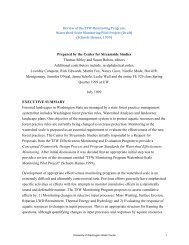- Page 1: c○ Copyright 2011 Katherine Nicho
- Page 5: University of Washington Graduate S
- Page 9: University of Washington Abstract U
- Page 13 and 14: TABLE OF CONTENTS List of Figures .
- Page 15 and 16: 3.1 Overview of Studies . . . . . .
- Page 17 and 18: 2.1 Participant Recruitment . . . .
- Page 19: Appendix B: Literature Search and L
- Page 22 and 23: 11.2 The Information Clips reading
- Page 24 and 25: 11.2 Examples of Calico reading too
- Page 27 and 28: ACKNOWLEDGMENTS This dissertation c
- Page 29: To the chemists Runge, Robiquet, Pe
- Page 33 and 34: CHAPTER 1 INTRODUCTION But when the
- Page 35 and 36: Introduction 3 Still, the very natu
- Page 37 and 38: Introduction 5 Figure 1.1: The PATT
- Page 39 and 40: Introduction 7 Forming the central
- Page 41 and 42: Introduction 9 the complex dynamics
- Page 43: Introduction 11 However, switching
- Page 46 and 47: 14 Chapter 2 1.1 Defining Reading D
- Page 50 and 51: 18 Chapter 2 The differing findings
- Page 52 and 53: 20 Chapter 2 Figure 2.3: The dual-r
- Page 54 and 55: 22 Chapter 2 Table 2.1: The 18 sens
- Page 56 and 57: 24 Chapter 2 Table 2.2: Summary of
- Page 58 and 59: 26 Chapter 2 to-right languages (e.
- Page 60 and 61: 28 Chapter 2 and obvious detriment
- Page 62 and 63: 30 Chapter 2 effect in which real w
- Page 64 and 65: 32 Chapter 2 prevalence rate of ADD
- Page 66 and 67: 34 Chapter 2 Given these negative a
- Page 68 and 69: 36 Notes to Chapter 2 NOTES TO CHAP
- Page 70 and 71: 38 Notes to Chapter 2 contains many
- Page 72 and 73: 40 Chapter 3 one item: technology f
- Page 74 and 75: 42 Chapter 3 purposes, legislation
- Page 76 and 77: 44 Chapter 3 Pepper and Lovegrove (
- Page 78 and 79: 46 Chapter 3 the range of font size
- Page 80 and 81: 48 Chapter 3 uses speech recognitio
- Page 82 and 83: 50 Chapter 3 Table 3.2: List of tec
- Page 84 and 85: 52 Chapter 3 accommodations are sug
- Page 86 and 87: 54 Chapter 3 Table 3.5: Occurrence
- Page 88 and 89: 56 Chapter 3 major field like compu
- Page 90 and 91: 58 Chapter 3 problematic for techno
- Page 92 and 93: 60 Notes to Chapter 3 NOTES TO CHAP
- Page 95 and 96: CHAPTER 4 [ASSISTIVE] TECHNOLOGY AD
- Page 97 and 98: [Assistive] Technology Adoption 65
- Page 99 and 100:
[Assistive] Technology Adoption 67
- Page 101 and 102:
[Assistive] Technology Adoption 69
- Page 103 and 104:
[Assistive] Technology Adoption 71
- Page 105 and 106:
[Assistive] Technology Adoption 73
- Page 107 and 108:
[Assistive] Technology Adoption 75
- Page 109 and 110:
[Assistive] Technology Adoption 77
- Page 111 and 112:
[Assistive] Technology Adoption 79
- Page 113 and 114:
[Assistive] Technology Adoption 81
- Page 115 and 116:
[Assistive] Technology Adoption 83
- Page 117 and 118:
[Assistive] Technology Adoption 85
- Page 119 and 120:
CHAPTER 5 METHODOLOGY DECISIONS It
- Page 121 and 122:
Methodology Decisions 89 Public awa
- Page 123 and 124:
Methodology Decisions 91 Internatio
- Page 125 and 126:
Methodology Decisions 93 Figure 5.1
- Page 127 and 128:
Methodology Decisions 95 be used. T
- Page 129 and 130:
Methodology Decisions 97 al., 1999)
- Page 131 and 132:
CHAPTER 6 CONCEPTUAL INVESTIGATION:
- Page 133 and 134:
Conceptual Investigation: Identifyi
- Page 135 and 136:
Conceptual Investigation: Identifyi
- Page 137 and 138:
Conceptual Investigation: Identifyi
- Page 139 and 140:
Conceptual Investigation: Identifyi
- Page 141 and 142:
Conceptual Investigation: Identifyi
- Page 143 and 144:
Conceptual Investigation: Identifyi
- Page 145 and 146:
Conceptual Investigation: Identifyi
- Page 147 and 148:
Conceptual Investigation: Identifyi
- Page 149 and 150:
Conceptual Investigation: Identifyi
- Page 151 and 152:
Conceptual Investigation: Identifyi
- Page 153 and 154:
Conceptual Investigation: Identifyi
- Page 155 and 156:
Conceptual Investigation: Identifyi
- Page 157 and 158:
Conceptual Investigation: Identifyi
- Page 159 and 160:
Conceptual Investigation: Identifyi
- Page 161 and 162:
Conceptual Investigation: Identifyi
- Page 163 and 164:
Conceptual Investigation: Identifyi
- Page 165 and 166:
CHAPTER 7 EMPIRICAL INVESTIGATION:
- Page 167 and 168:
Empirical Investigation: Online Dis
- Page 169 and 170:
Empirical Investigation: Online Dis
- Page 171 and 172:
Empirical Investigation: Online Dis
- Page 173 and 174:
Empirical Investigation: Online Dis
- Page 175 and 176:
Empirical Investigation: Online Dis
- Page 177 and 178:
Empirical Investigation: Online Dis
- Page 179 and 180:
Empirical Investigation: Online Dis
- Page 181 and 182:
Empirical Investigation: Online Dis
- Page 183 and 184:
Empirical Investigation: Online Dis
- Page 185 and 186:
Empirical Investigation: Online Dis
- Page 187 and 188:
Empirical Investigation: Online Dis
- Page 189 and 190:
CHAPTER 8 EMPIRICAL INVESTIGATION:
- Page 191 and 192:
Empirical Investigation: Life Stori
- Page 193 and 194:
Empirical Investigation: Life Stori
- Page 195 and 196:
Empirical Investigation: Life Stori
- Page 197 and 198:
Empirical Investigation: Life Stori
- Page 199 and 200:
Empirical Investigation: Life Stori
- Page 201 and 202:
Empirical Investigation: Life Stori
- Page 203 and 204:
Empirical Investigation: Life Stori
- Page 205 and 206:
Empirical Investigation: Life Stori
- Page 207 and 208:
Empirical Investigation: Life Stori
- Page 209 and 210:
Empirical Investigation: Life Stori
- Page 211 and 212:
Empirical Investigation: Life Stori
- Page 213 and 214:
Technical Investigation: Value Anal
- Page 215 and 216:
Technical Investigation: Value Anal
- Page 217 and 218:
Technical Investigation: Value Anal
- Page 219 and 220:
Technical Investigation: Value Anal
- Page 221 and 222:
Technical Investigation: Value Anal
- Page 223 and 224:
Technical Investigation: Value Anal
- Page 225:
Technical Investigation: Value Anal
- Page 228 and 229:
196 Chapter 10 to focus on website
- Page 230 and 231:
198 Chapter 10 two-fold. The first
- Page 232 and 233:
200 Chapter 10 with fellow classmat
- Page 235 and 236:
CHAPTER 11 TECHNICAL INVESTIGATION:
- Page 237 and 238:
Technical Investigation: Designing
- Page 239 and 240:
Technical Investigation: Designing
- Page 241 and 242:
Technical Investigation: Designing
- Page 243 and 244:
Technical Investigation: Designing
- Page 245 and 246:
Technical Investigation: Designing
- Page 247 and 248:
Technical Investigation: Designing
- Page 249 and 250:
Technical Investigation: Designing
- Page 251 and 252:
Technical Investigation: Designing
- Page 253 and 254:
Technical Investigation: Designing
- Page 255 and 256:
Technical Investigation: Designing
- Page 257 and 258:
Conclusions and Future Work 225 wit
- Page 259 and 260:
Conclusions and Future Work 227 the
- Page 261 and 262:
Conclusions and Future Work 229 int
- Page 263 and 264:
Conclusions and Future Work 231 del
- Page 265 and 266:
BIBLIOGRAPHY References marked with
- Page 267 and 268:
Bibliography 235 Burgstahler, S. E.
- Page 269 and 270:
Bibliography 237 ∗ Edwards, J. H.
- Page 271 and 272:
Bibliography 239 Glasgow, Scotland,
- Page 273 and 274:
Bibliography 241 Retrieved October
- Page 275 and 276:
Bibliography 243 supporting group w
- Page 277 and 278:
Bibliography 245 S. R. Goldman (Eds
- Page 279 and 280:
Bibliography 247 J. A. Jacko & A. S
- Page 281 and 282:
Bibliography 249 Tsovili, T. D. (20
- Page 283:
Bibliography 251 Educational Resear
- Page 286 and 287:
254 Table A.1: Descriptions and spe
- Page 289 and 290:
APPENDIX B LITERATURE SEARCH AND LA
- Page 291 and 292:
Literature Search and Labeling of A
- Page 293 and 294:
Literature Search and Labeling of A
- Page 295 and 296:
Literature Search and Labeling of A
- Page 297 and 298:
Literature Search and Labeling of A
- Page 299 and 300:
Literature Search and Labeling of A
- Page 301 and 302:
Literature Search and Labeling of A
- Page 303 and 304:
Literature Search and Labeling of A
- Page 305:
Literature Search and Labeling of A
- Page 308 and 309:
276 Appendix C weight can capture t
- Page 310 and 311:
278 Appendix C time the task will t
- Page 312 and 313:
280 Appendix D This article is a st
- Page 314 and 315:
282 Appendix D Faculty Support Fair
- Page 316 and 317:
284 Appendix D Themes Values Assist
- Page 318 and 319:
286 Appendix D Formulated from year
- Page 320 and 321:
288 Appendix D Ladner, R. E. (2008)
- Page 322 and 323:
290 Appendix D Support Failure Acco
- Page 324 and 325:
292 Appendix D Quality of Life Empo
- Page 326 and 327:
294 Appendix D employment, and soci
- Page 328 and 329:
296 Appendix D Family Support Commu
- Page 330 and 331:
298 Appendix D Themes Values Assist
- Page 333:
VITA For the first 10 years of her
















